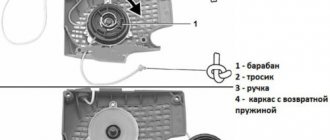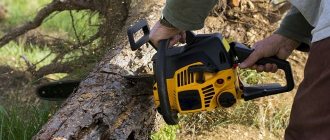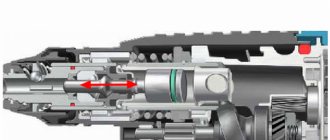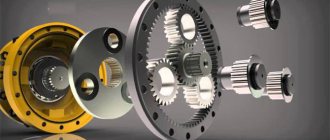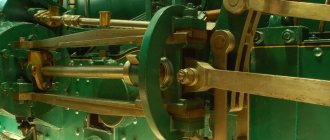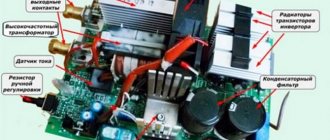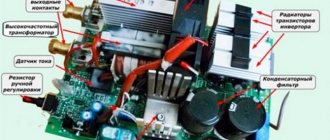It would seem, why does a summer resident who grows vegetables and fruits, or the owner of a country house with a small garden and several flower beds, need a chainsaw? The question disappears when the desire arises to build a bathhouse, update a greenhouse, knock down an old business, or simply make a bench for relaxation. Unfortunately, any mechanism periodically needs maintenance and replacement of spare parts, and for this you need to have a good understanding of the structure of the product, besides, repairing a chainsaw with your own hands will save time and money.
Structural components of a chainsaw
All chainsaws are similar in structure, regardless of whether they are made in Europe (ECHO, Stihl, Husqvarna) or domestic (Kedr, Ural). Inside the body there are the main elements - the fuel tank and the engine, and outside there is a starter, a handle, a saw part (tire) with a chain. A sharp tug of the cable starts the engine, and it starts the saw blade.
To begin with, we invite you to familiarize yourself with videos that show how a chainsaw works and how it works:
From time to time, malfunctions occur in the operation of the saw, which require disassembly to eliminate. What can happen to such a simple mechanism as a chainsaw? At least the following:
- Stops starting;
- It starts, but soon stops;
- Stops functioning when cutting;
- Loses its power;
Most problems are associated either with interruptions in engine operation (fuel supply system, exhaust system, ignition, cylinder-piston part), or with malfunctions of other systems and components (clutch, chain brake, tire, lubrication system). Let's look at the most common breakdowns and methods for eliminating them.
A serviceable chainsaw starts with one pull and does not fail to cut
Starter repair Husqvarna and Shtil - subtleties and features of the work
To repair a starter on a Shtil 180 saw, you need to carry out the following step-by-step steps:
Upon completion of the system repair, you need to reassemble it in the correct order. Namely, the pulley is located above the starting spring, firmly engaging with it; it is wrapped with a cord, the edge of which is threaded into the lid so that at the moment of start the pulley winds the cable inward. The required voltage can be achieved by making four turns. You can find out all the details of the procedure for yourself in a detailed video.
Repairing a Husqvarna starter is almost no different from similar operations performed with a Shtil starter, but an important nuance here is ensuring that the parts match the chainsaw itself. That is, if you try a reel from a completely different saw, this may lead to unpleasant consequences in your work. It’s another matter if the store recommends a cheap analogue with which your saw will work for a long period. It is worth noting that for Husqvarna 142 or Shtil 180, as the most popular consumer saws, you should not use homemade elements, for example, a cord or other devices. The starter spring is one of the most frequently replaced parts. This is partly due to the fault of the operator if he regularly exerts excessive force to start the saw, and sometimes due to the unreliability of fastening one of the edges of the spring. In the same way, you need to replace parts on a Ural saw, perhaps with a little more physical effort.
Checking the ignition system
The first thing you need to do if your chainsaw breaks down is to inspect the spark plug by disconnecting the wire and carefully unscrewing it with a special wrench.
Components of the chainsaw ignition system: 1 – flywheel with magnets, 2 – ignition module, 3 – spark plug, 4 – high voltage wire
The spark plug is unscrewed to check its condition
Her appearance speaks volumes:
- Dry. Most likely, the fuel mixture is not getting into the cylinder. The problem is not in the ignition system, so the spark plug is screwed back in.
- Heavily splashed with fuel. The reason for the excess fuel mixture lies either in violation of the starting rules or in incorrect carburetor adjustment. The spark plug is thoroughly wiped, the fuel supply is turned off and the starter is turned on to remove excess fuel and ventilate the combustion chamber. Then the candle is placed in place and the mechanism is started again.
- Covered with black soot. This may indicate the use of low-quality oil, an incorrectly adjusted carburetor, or an incorrectly calculated ratio of gasoline to oil. The spark plug should be washed, removed from carbon deposits with a sharp object (an awl or a needle), the electrodes should be wiped with sandpaper and placed in place.
When checking the spark plug, you need to pay attention to the gap between the electrodes: 0.5 to 0.65 mm is considered normal. A damaged or worn gasket must be replaced.
A large amount of black carbon deposits on the spark plug indicates problems with the engine.
To be completely sure, you should also check for a spark. To do this, put the ignition cable on the spark plug, connect the spark plug nut and the cylinder with pliers, turn on the starter and watch for the appearance of a spark. If it is missing, the spark plug needs to be replaced. If the new spark plug also does not produce a spark, the problem is in the high-voltage wire or in a broken connection to the spark plug.
No. 2. The engine stalls
The engine starts, but the chainsaw stalls at idle or under load. In this case, most often you should perform the same actions as described above.
How to adjust a chainsaw depends on exactly when the problems start:
Stalls immediately after starting:
- The fuel mixture is not prepared correctly, there is too much oil in it, so the octane number of gasoline is less than it should be, so the chainsaw only runs on choke or stalls immediately.
- Carbon deposits on the spark plug or improper gap between the spark plug and the wire.
It stalls and does not work at idle:
- The muffler is clogged. It is necessary to remove carbon deposits.
- The carburetor settings are off. The idle speed on the chainsaw needs to be adjusted. This is done using adjusting bolts marked L and H. For how to adjust idle speed, see the article about adjusting the carburetor.
Stalls at maximum speed and only runs on choke
- The air or fuel filter is clogged. The seals need to be cleaned and checked.
- The breather is clogged and because of this, fuel does not flow and pumping gasoline on the chainsaw does not work. Take the needle and carefully clean the breather.
- Fuel pump malfunction. Remove the pump and check to see if gasoline is leaking from it. If it oozes, replace the sealing gasket or the pump itself.
The chainsaw does not cut under load and stalls
- The air filter is clogged. It is necessary to take out the filter, clean it well or even rinse it, dry it and install it back.
- Wrong proportion of oil/gasoline mixture. Drain the fuel and remix the oil and gasoline in the correct proportions.
Fuel supply system repair
Fuel may not enter the cylinder for the following reasons:
- Fuel filter is dirty. You should remove the fuel hose and check how the fuel flows. If the stream is weak, the filter may need to be cleaned. It is taken out through the filler hole of the fuel tank and cleaned; in case of severe contamination, it is replaced with a new one. As a preventative measure, it is recommended to replace the fuel filter once every three months.
- Clogged breather (hole in the fuel tank cap). They also check by disconnecting the hose; if clogged, clean it with a needle.
- Lack or insufficient fuel. There may be several reasons for the malfunction. The first reason is a clogged air filter. Air stops flowing into the carburetor in the required quantity, and therefore, due to the fuel mixture being too rich, engine operation is disrupted. The dirty filter is carefully removed, cleaned and rinsed in water, then dried and replaced.
Another reason is incorrect carburetor adjustment. Adjustment is made with three screws.
Timely replacement of the fuel filter guarantees a complete fuel supply
The fuel hose and choke actuator must fit tightly to the fittings
The throttle cable must be in place.
During work, you must use the instructions, otherwise you can only make things worse.
And the last reason is a violation of the integrity of the membrane or clogging of the carburetor channels.
All parts must be clean, dry and in good working order.
Owner reviews
Evgeniy, 40 years old
I bought it purely for collecting firewood, for a good job once a year. The price is the same, it cuts - and thank God! Professional Husqvarna models in my case will not pay off soon. I have already prepared firewood for two seasons, the saw is in good condition. I think there will be no problems in the future.
Advantages: cuts even large logs well, cheap.
Anton, 34 years old
I bought a Husqvarna chainsaw second-hand from a visiting dealer 2.5 months ago. At first I was worried that it might be fake (which was actually confirmed), but then I let go of the situation, since I still can’t afford a more expensive and original one. Externally, the saw is a little rough, the lid does not fit tightly, but it cuts perfectly. I cleaned up the trees on the site, everything I cut down was used for firewood. The chain is rather weak and gets dull quickly.
Pros: price, cuts well.
Disadvantages: none found.
Vitaly, 39 years old
Disassembling and cleaning the muffler
If the engine runs great at low speeds, but starts to stall at high speeds, the reason may lie in the muffler spark arrester, which is clogged with combustion products.
- remove the muffler;
- disassemble (there are also non-dismountable models);
- remove carbon deposits using detergents;
- dry with a hairdryer;
- install in place.
Dry cleaning is unacceptable, as carbon deposits contain carcinogens, the inhalation of which is hazardous to health. After removing the muffler, cover the exhaust hole with a clean rag.
Interruptions in the operation of the chainsaw indicate a possible clogging of the muffler
To prevent clogging of the muffler, it is necessary to monitor the composition of the fuel mixture. The amount of oil should not exceed the standards recommended by the manufacturer. Poor oil quality also negatively affects engine performance.
Assessment of the condition of the cylinder-piston group
Often the engine does not start or does not operate at full capacity due to low pressure in the cylinder. It can be caused by wear of the piston or cylinder, stuck piston rings, or worn bearings. You can partially examine the condition of the cylinder-piston group (CPG) by removing the muffler and looking into the opened hole.
A compression gauge placed in the spark plug hole will help measure the compression in the engine - based on the measurement results, we can also talk about the condition of the CPG. Accurate data is obtained only after complete disassembly of the mechanism. If the piston is chipped or scratched, it needs to be replaced. The piston ring must be clean, free of carbon deposits, and be exactly in place.
Wear of the piston and crank mechanism is considered a serious problem
Based on the results of compression measurements, one can judge the condition of the CPG parts
Chainsaw design and general classification of faults
Correctly find the source of the malfunction, as well as perform correct and high-quality repairs of chainsaws; for this you need to have a reliable understanding of its technical specifics. Repairing such equipment is not particularly difficult. Its schematic structure is quite simple. For convenience, the nodes in its composition can be divided into three types:
- The main and very important element, without which further work is impossible, is a two-stroke engine running on gasoline. Acceptable brands of gasoline are indicated in the device passport itself;
- the second equally important component is its working part, which is responsible for sawing the materials themselves. This includes sawing mechanisms;
- The third connecting unit includes a system for supplying and filtering fuel, oil, engine ignition, exhaust gas removal, etc.
Chainsaw engine malfunction
Problems are classified into two nodes:
- Malfunction of the engine itself. It cannot start, it stalls for no reason, it heats up excessively, it smokes a lot, it works unstably with minimum and maximum load. Therefore, repairs need to be carried out on these units.
- Peripheral problems. Here you can identify many symptoms that indicate malfunctions in its operation. For example, if the chainsaw stalls during operation or loses power, there may be a blockage in the gasoline supply system or filter. If it cuts poorly, then the chain may simply be dull. Repairs should begin with a study of the auxiliary components, which will require the least amount of time and equipment.
For convenience, before starting repairs, you should divide the chainsaw into sectors and look for a fault directly where the problem is suspected. The manual also provides a brief description of possible breakdowns and how to eliminate them.
It should also be borne in mind that several factors can serve as sources for the same malfunction. Therefore, it is important to be able to diagnose the cause of the breakdown in order to carry out repairs correctly and efficiently in the future. Before you start disassembling and repairing a chainsaw, you should estimate the possible causes and try to work only with them.
Weak points of the saw bar
The main parts of the tire are the body and the groove. The width of the latter is called the gap. The front part of the saw bars is made of high-strength steel. The tire body is also hardened.
Currently, there are various types of saw bars on sale, which differ in:
- body length and width;
- gap size;
- the presence of a high-strength nozzle on the front part;
- the presence and type of driven sprocket hidden in the front of the tire body.
Different types of saw bars
The shape of the shank and the location of the technological holes in the bars are standard for most amateur and professional chainsaws, but structurally they can be divided into open and closed. Obviously, the former are inferior in terms of reliability of attachment to the body of the latter, i.e. The tire casing and bolted connection bear increased loads. You also need to monitor the integrity of the sprocket teeth - if they become dull or chipped, they will quickly render the leading links of the chain unusable.
Parameters and options for chainsaw tires and their elements in the photo
The chainsaw tire requires regular maintenance. After each operating session, its grooves must be cleaned of dirt and sawdust, otherwise lubricant will not flow to the chain. The wear of the tire groove should be uniform, so it should be turned over from time to time. In addition, before starting work, you should always check the presence of oil on the chain body and in the gap.
Checking the operation of the lubrication system
It is not recommended to use more than three chain sets with one bus. During operation, the gap, despite all the strength of the metal of the tire body, expands, which leads to the appearance of play when the chain moves and its sagging even with the extreme forward position of the tire.
The driven sprocket, located at the front of the tire, is lubricated separately. Oil does not get there, unlike the rest of the guide groove. It is poured into special holes in the front of the tire, and if there is no sprocket, it is applied to the toe of the tire.
What is needed to fix the problem?
Repairing a chainsaw does not require a large arsenal of household tools. First of all, this:
- screwdrivers. Cross and flat to remove the casing, chain or other components that are fastened with flat bolts and will definitely be needed to properly repair the chainsaw;
- a set of spanners and wrenches of different sizes. They will be needed when disassembling the engine and other moving parts. Repairing such parts sometimes involves dry cleaning, so they will be needed to scrape off excess dirt;
- key for removing spark plug;
- a diagram of the chainsaw itself in order to know how certain components work and how to properly maintain them.
DIY chainsaw repair, fuel supply system
The most common breakdowns that require repair of their parts include problems with the engine and fuel supply system. It happens that it is impossible to develop the nominally maximum power of a chainsaw, or the chainsaw suddenly stalls after some time, or it is not possible to start it at all.
Fuel supply system
This happens in two cases:
- problems with the fuel mixture ignition;
- problems with the delivery of gasoline from the tank to the engine.
Finding the causes of failure and repairing a chainsaw should always start with the elements that will require the least amount of time and money, namely the spark plug. Its direct purpose is to generate a spark and ignite the gasoline mixture with air. A simple visual inspection of this element can tell you a lot and tell you where to start repairing.
- The absence of a spark in the gap indicates poor contact with the wire or a malfunction of the spark plug itself. It is necessary to check all contacts and the spark plug itself. A new spark plug is installed in the cradle, and if it also does not produce a spark, then the problem lies in the contacts and the wire itself. They need to be changed.
- A dry spark plug is the first sign that fuel is not being supplied to the carburetor at all. The cause of the breakdown is a blockage in the fuel filter element or breather. It is necessary to rinse, if this does not work, then change the filter. Manufacturers recommend changing it at least once every three months.
- Excessive fuel presence on the spark plug head indicates incorrect carburetor adjustment or incorrect starting. The repair involves simply removing the spark plug, which needs to be wiped with a dry cloth. It is also necessary to check the chambers in which the fuel burns directly.
- The candle is covered with soot. This indicates an excessive flow of gasoline mixture into the combustion chambers, poor quality of oil, incorrect carburetor settings, or incorrect proportions of oil and fuel. Repair here is carried out by washing the spark plug, then wipe it dry with a rag. The gaps should also be cleaned with a sharp needle or awl. Problems with the carburetor usually arise when its settings are lost, the membrane wears out (only replacing it will help here), or there is a blockage in its channels (should be disassembled and cleaned).
Replacing the chainsaw filter
Repairing chainsaws with your own hands is always not an easy task, even for an experienced person who knows almost everything about technology. Most of the time is spent diagnosing a malfunction, when you need to find the source of all problems with equipment.
Troubleshooting muffler problems
It happens that the engine runs calmly and without problems at zero load, but when it increases, it stalls or runs intermittently. This is caused, as one of the reasons, by a blockage in the muffler. The source of the blockage can be combustion products of waste materials, an excess of oil in the combustion mixture, or its poor quality. In such a situation, repairing a chainsaw will not be so time-consuming, since to fix the problem, you only need to clean the muffler. Most often, the spark arrestor becomes clogged with combustion products of gasoline vapors.
No. 8. The chain falls off
Why does the chain fall off the tire? There may be several reasons and they are all different:
- Worn drive or driven sprocket. Due to the fact that the sprocket is worn out, the grip on the chain decreases, which is why the chain flies off the chainsaw. The sprocket needs to be replaced.
- The chain has stretched. Why the chain on a chainsaw stretches is due to insufficient lubrication. The metal heats up and stretches, even by a fraction of a millimeter, but if you take into account the number of links, then even 3-4 mm is enough for the chain to fly off the bar. The chain needs to be replaced.
- The chain tensioner that regulates its tension has become loose. how to regulate a chainsaw, or rather the chain tension? You need to adjust the tensioner - this can be done in just a few minutes.
Repair of cylinder-piston group (CPG)
Sometimes it happens that the engine is not able to reach maximum power or start due to insufficient pressure in the cylinders. The source of such problems is sometimes faulty piston rings, problems with the cylinder, bearings, or wear of the piston itself. Therefore, repairing a chainsaw should begin with a visual inspection of the engine cylinders. Inspection is possible through the hole where the spark plug is installed to ignite the mixture. The overview under such conditions will remain minimal, but a first idea of the state of the working group at this stage can be obtained.
You can also insert a compression gauge into the spark plug hole. Rotate the starter or crankshaft. The pressure inside must be at least 8 atmospheric units. At lower values, the engine will not work due to insufficient pressure created inside. As the pressure decreases, the engine power itself also decreases.
A more detailed picture of what is happening inside can be seen by disassembling it. To do this, remove the crankcase and visually inspect the piston. If there are chips, dents or scratches, it should definitely be replaced. The piston pins must also be in good condition without damage and not loose. If this happens, then you should definitely change them.
A decrease in pressure inside the engine also involves failure of the piston rings. This can be immediately noticed, since the working ring is not covered with carbon deposits, it is located freely in the groove and does not dangle, and is pressed tightly inside the cylinder.
Replacing chainsaw piston rings
You should also examine the surface of the inside of the cylinder. If it is already worn out, then it should be squandered.
No. 10. Chain brake does not work
All chainsaws are equipped with a main and inertial (emergency) brake. The latter turns on only when a backfire occurs. The main brake is designed to stop the chain while the engine is running. Why does the chain on the chainsaw jam and it doesn’t stop? Option two:
- The brake band is badly worn and does not provide sufficient stopping effect. The brake band needs to be replaced.
- Contamination of the tape. When working, debris may become clogged in the under-cover space: shavings, sawdust, dirt, etc. Debris is blocking the brake mechanism, so if the brake does not work, you need to clean the brake mechanism.
Source
Checking the carburetor and signs that it needs adjustment
The rated engine power and savings in fuel consumption depend on the good condition of the carburetor. The carburetor of a chainsaw has no functional difference from a car. It mixes gasoline vapors with air entering through the pipe and delivers them further into the combustion chamber.
- air duct or tube for air supply;
- fuel line or fuel supply tube for mixing it with air;
- air damper.
A sign that the carburetor needs to be adjusted:
- strong vibrations due to unbalanced screws. An engine with a working carburetor runs smoothly and sounds like a four-stroke stroke;
- damage to the protection cap;
- wear of the piston system, which already requires a different mixture in composition;
- involuntary engine shutdown, inability to restart or initially start;
- an unreasonable increase in gasoline consumption, while engine power may remain the same, but most often decrease;
No. 3. The engine "shoots"
If during operation there are extraneous sounds similar to gunshots, then there is a problem with the muffler or carburetor. How to make a chainsaw run quietly? It depends on which node is faulty.
Shoots the carburetor:
- Ignition is too late - the air-fuel mixture does not have time to burn out in the cylinder, so the sound is similar to a small explosion.
- Lean air-fuel mixture. Too little gasoline enters the mixture - the chainsaw, or rather the jets, needs to be adjusted to increase the fuel supply. Why the chainsaw revs on its own is for the same reason.
Shoots at the silencer:
- Enriched air-fuel mixture. Why does a chainsaw “shoot”? There is too much gasoline and not enough air in the mixture, so the mixture does not completely burn out in the chamber and partially burns out in the muffler. Carbon deposits on the exhaust are a clear sign of this. The air filter needs to be cleaned or the carburetor adjusted.
Calibration algorithm and safety precautions when troubleshooting a chainsaw carburetor
Calibration or fine adjustment of the carburetor should be carried out strictly as recommended by the chainsaw manufacturer itself. Often this procedure has already been done during the assembly phase in the assembly shop. However, chainsaw repairs sometimes include carburetor adjustments. This is due to its incorrect operation for technical reasons, settings failure, etc.
Fine adjustment is made using three bolts:
- bolt “L” regulates fuel supply at low speeds;
- bolt “H” regulates the maximum fuel supply to the engine;
- The "T" bolt regulates the fuel supply at idle.
There are two types of carburetor settings:
- main or basic. Performed with the engine turned off;
- exact or final. Performed on a warm engine.
First, the “H” and “L” bolts, which regulate the supply of the fuel mixture at high and low speeds, respectively, are tightened counterclockwise all the way. Next, turn them one and a half turns clockwise. It is advisable, before starting the procedure, to mark the initial position of these bolts with a pencil or felt-tip pen, in order to subsequently return them to the position in which they were before if problems with adjustment arise. The fact is that with an unskilled approach to adjustment, it is possible to completely kill the engine.
Further adjustment takes place with the engine warmed up to the desired temperature. It is left running for 10 minutes. Next, they fine-tune the idle speed adjustment bolt. It is turned until the engine (its speed) reaches the minimum values. The engine must run stably and the chain must remain in place (not rotating).
Then you should check how quickly the momentum picks up. To do this, slowly turn the low speed bolt another eighth of a turn. The maximum possible speed can be set using the tachometer and adjusting the “H” bolt. Next you should check the carburetor operation at idle again.
No. 9. The chain does not rotate
Why doesn't the chainsaw chain rotate when the engine is running even at full speed?
- Leading sprocket. Either it is jammed, or the crown is worn out so much that it does not engage and the chain does not spin on the chainsaw. In any case, it is necessary to disassemble the sprocket to find out the exact reason why the chain does not spin. If the crown is worn out, it is necessary to replace the sprocket (or the crown itself, if the sprocket has a prefabricated structure).
- The chain brake is stuck. As a result, the sprocket is blocked by the brake mechanism, while the motor runs. It is necessary to turn off the engine and release the brake. If this happens under load, the brake mechanism will have to be changed, as well as the sprocket, because Due to the high temperature, many elements can melt and overheat.
Other chainsaw malfunctions
In addition to the main components, the chainsaw has a number of other less functional, but no less important components. Breakdowns happen here too, but they are much easier to identify and fix.
- System malfunction due to fuel vapor ignition. This could include a starter failure. It happens that the cable breaks, the return spring jumps out or completely breaks. The contacts between the high-voltage wire and the spark plugs wear out.
- The operation of the lubrication system itself is disrupted. The cause may be poor quality or unsuitable oil, or the lubricants themselves. You can even simply add lubricant to the necessary components in time.
- It happens that the chain brake starts to work incorrectly. To eliminate this problem, you need to configure it correctly. Clean it, as it sometimes becomes very clogged with sawdust.
- The saw chain becomes dull or wears out. If it is not possible to sharpen the chain yourself, then you should give it to a professional sharpener. It will cost money, but much less than buying a new one.
Causes of spark plug problems
As mentioned earlier, the cause of failure of spark plugs is, first of all, a violation of contacts between the wires or a malfunction of the fuel system itself. To analyze such a malfunction, you should unscrew the spark plug and carefully examine it. Its completely dry condition tells the owner that fuel simply does not enter the cylinders. A wet head indicates that the fuel in the cylinders is not igniting, or there is moisture somewhere in the system. First of all, you need to dry the candle. This is done with the valve open and the tap closed.
Diagnostics of spark plug condition
You may need to replace the gasoline or the spark plug itself. The presence of carbon deposits on the head indicates an imbalance between the gasoline and oil compositions. The fuel filter element may be clogged. The problem can be solved by changing the fuel itself, filters and cleaning the fuel supply system of the chainsaw.
